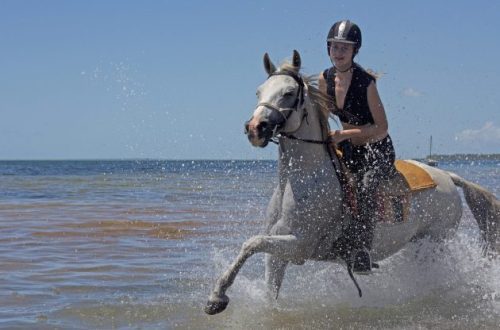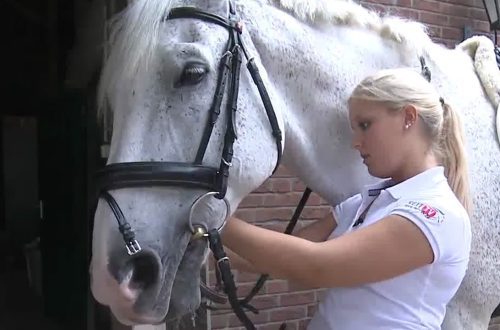
Basic principles of horse nutrition
Basic principles of horse nutrition
The most important part of a horse’s diet is roughage. (in this case, the term “roughage” includes fresh grass too – translator’s note) either as hay or fresh grass, or a combination of the two.
The gastrointestinal tract of the horse is designed to digest large amounts of roughage; it has a huge population of microorganisms that feed on fiber, and the shape of the intestine (including all the curves) ensures maximum fermentation, digestion and absorption of nutrients. At the same time, being well adapted to life on a pasture, the GI tract of a horse does not feel very well when it comes to having to settle for a small amount of hay or a large amount of grain concentrates. Accordingly, it is essential to strive to maximize the amount of roughage in the horse’s diet.
If for some reason the horse cannot eat enough roughage (for example, he has problems with his teeth and cannot chew), he should be given another diet with a high fiber content, such as beet pulp.
As a general rule, the horse’s diet should include roughage in the amount least 1% of its weight (dry matter). Thus, the minimum amount of hay per day for a horse weighing 500 kg is about 6 kg. Ideally, give more (1,5% – 2,5% of the horse’s weight depending on the circumstances). Any concentrates, if needed, should be no more than 1% of the horse’s weight per day, and should never be more than roughage. Most horses eat 1,5% – 3% of their body weight, with the upper limit usually fed to lactating mares or horses in very hard work.
Many horse owners underestimate how nutritious roughage is for a horse. 5 kg of hay per day (even if it’s just timothy) provides 9,95 Mcal of energy, 485 g of protein, 24 g of calcium and 11,5 g of phosphorus. At the same time, the daily needs of a horse weighing 500 kg without load are only 16,65 Mcal of metabolic energy, 630 g of protein, 20 g of calcium and 14 g of phosphorus. If this hay is given in an amount of 2% of the horse’s weight, then the amount of energy, protein, calcium and phosphorus will cover the needs in excess.
However, in many cases, hay alone cannot provide all the mineral needs of a horse (especially salt, as well as some trace elements). Salt lick with micronutrients can make up for the lack of them for a horse that eats only hay. If you’re not sure about the protein content of your hay, you can add a protein balancer to your diet. Also, a balancer (or vitamin and mineral supplement) can be recommended if the hay is old and its vitamin composition leaves much to be desired.
The graph shows the provision of protein requirements of different groups of horses (adult horse without load, foal at the age of 1 year, foaling mare, lactating mare, horse with an average load (adult weight 500 kg)) in protein when consuming hay from alfalfa and timothy (timothy ) in an amount of 1,5% by weight. The horizontal line captures 100% of demand.
As you can see from the graph, an unloaded adult horse easily covers its protein requirements with 7,5 kg of plain timothy hay. If such a horse is fed with alfalfa hay, which is richer in protein, because. Since alfalfa is a legume, it will receive too much protein. Excess protein in the diet is metabolized into energy in a very inefficient way, and a large amount of unnecessary nitrogen is excreted in the urine as ammonia (which greatly contributes to bad odors in the stable).
However, if we look at a yearling weighing around 320 kg, it turns out that his protein requirements are significantly higher than those of an adult horse. It is no longer possible to cover them with timothy hay, but it is possible with alfalfa hay. If you only have timothy grass (or any other grass hay), the yearling will need to add concentrated food containing the right amount of the missing protein, or increase the amount of hay (the choice depends on calorie requirements). We observe the same situation in foals and working horses. However, in the early stages of lactation, the need for protein in mares is so high that even alfalfa hay in an amount of 1,5% of the mare’s weight does not cover it. This example shows that cereal hay is quite suitable for most horses, and if given in slightly more amounts than suggested on the chart, or if a small amount of concentrated feed is added, the protein requirements of most groups of horses will be quite satisfied. Moreover, the graph shows that alfalfa hay is excessive in protein for most horses!
Choice of concentrates
Concentrates (grains or commercially prepared feeds) are usually added to the ration when the horse’s nutrient requirements cannot be met by roughage alone. For example, lactating mares or horses carrying very high loads have such high nutrient requirements that they simply cannot physically eat the appropriate amount of hay. Concentrated feed is also useful when training a horse or for giving medicine or food.
Let us note again that most horses don’t need concentrates at all! Most horses carry light to medium loads and can easily cover all their needs with hay alone.
If your horse does need a concentrated feed, pre-packaged commercial feeds are most convenient because they are already balanced for all the nutrients. Some horse owners prefer to mix the feed themselves, but it must be emphasized that in this case it is good to consult a nutritionist.
Many horse owners believe that if a substance is useful, then the more it is given to the horse, the better (especially vitamins and minerals). However, some vitamins and minerals are toxic to horses even in small amounts, and it is very easy to overdose them. For example, an owner buys a ready-made feed for a horse (usually it already contains a vitamin-mineral premix), then adds a vitamin-mineral supplement, and then decides to add additional supplement with vitamin E and selenium. In this case, the horse can receive a triple rate of vitamin E and selenium. Vitamin E is relatively non-toxic (although too much can interfere with the absorption of other nutrients), but high doses of selenium can cause poisoning.
The other side of the coin when choosing concentrated foods is the source of calories. In terms of energy, calories derived from fat are no different from calories derived from carbohydrates (of course, the number of calories per kilogram varies, but calories are calories, regardless of the source), but the foods themselves can be very different.
So, if the horse’s diet consists of feeds rich in starch and sugar (cereals), in the digestive tract they are converted into glucose, which is rapidly absorbed into the blood. Some horses are very sensitive to spikes in blood glucose and will become very “hot” after another serving of grain or a high molasses diet. This is very similar to a child who, after eating a chocolate bar, becomes hyperactive and “runs on the ceiling.” Some owners even rejoice at such an effect from the diet, so it is worth noting that this effect is rather short-lived, and a sharp spike in blood glucose is followed by an equally sharp decline. For horses that are especially sensitive to such surges, it is better to choose feeds that do not contain large amounts of starch and sugar. Feeds rich in fat or fiber do not lead to sharp fluctuations in blood glucose.
Another problem with foods containing sugar and starch is their potential hazard to the digestive process. As noted above, the ability of horses to digest starch is very limited, therefore, when a large amount of starch enters the gastrointestinal tract, it can reach the posterior intestine (caecum and colon), where it will quickly begin to be fermented by microorganisms. This rapid fermentation leads to increased gas production and can result in colic, acidity, and high levels of toxins, which in turn can lead to laminitis. Remember, a healthy digestive tract is a healthy horse!
Starchy-sugar diets have another danger: they adversely affect insulin sensitivity. The hormone insulin regulates the concentration of glucose in the blood by helping glucose move from the blood to the muscles and body fat. If a horse often consumes “sweet” feeds, blood glucose rises several times a day. In this regard, the level of insulin also rises, which should regulate glucose and push it into the muscles (or fat). Frequent spikes in blood glucose and insulin are believed to eventually lead to insulin resistance. (i.e. more and more insulin will be required to lower blood glucose levels – translator’s note). Due to the problems caused by insulin resistance, diets based on fiber and fat have become increasingly popular in recent years. They may be similar in terms of calories per kilogram, but are metabolized differently and therefore do not lead to peaks in glucose and insulin. Such feeds contain ingredients such as beet pulp, rice bran, and vegetable oil. If a horse does not do well on a diet containing sugar and starch (especially in large quantities), replacing some of the calories with calories from fiber and fat may be a good alternative for them.
It should be noted that a diet low in sugar and starch is not a low-carbohydrate diet, since fiber is also a carbohydrate. If the diet lacked fiber, this would lead to serious gastrointestinal upset and would significantly damage the health of the horse. So the fiber-fat diet isn’t low-carb—it’s just low-sugar-starch.
Feed quality
Many owners misunderstand the concept of quality when it comes to horse food. Most horses don’t need super nutritious hay (such as alfalfa) and do quite well on lower “quality” hay. However, good hay should be green, leafy, smell good, and be free of mold, dust, and foreign objects. Very nutritious high protein hay can be dusty and moldy and should never be fed to horses. At the same time, less nutritious hay with a low protein content can be fresh, green and quite edible – and is fine for most horses.
Grain should also be of the highest grade possible, and more and more feed manufacturers are now trying to switch to products suitable for human consumption. Horses should not be fed compound feed intended for cattle and other farm animals and poultry.because some of the ingredients in these feeds, such as antibiotics and coccidiostats, can be extremely toxic to horses!
Other aspects of nutrition
The transition to any new feed, including grain and hay, should be done gradually, at least within a week, and preferably ten days. This gives the gastrointestinal tract and its microflora the opportunity to adapt to the new food. As a general rule, in the first 3 days they give up to 25% of the new feed, in 4-6 days – 50%, in 7-10 days – 75%. On the 11th day, you can enter a new food at a full dose. If your horse already has a history of colic on the new feed, it’s best to stretch the process even further, adding 10%-15% instead of 25%.
As you may have noticed, most feed recommendations are given by weight (in kilograms). The weight of the food is very important for the preparation of the diet., since spoons, ladles and garnets can vary significantly in the understanding of different people. In addition, different feeds have different densities. For example, a liter of oats weighs less than a liter of corn. Of course, there is no point in weighing food every day – just knowing how much your “ladle” of a particular food “weighs” is enough. In the same way, you can weigh several bales of hay to get at least a rough idea of how much hay your horse eats in kilograms, and not in bales.
How to calculate diet
In addition to some ability to apply mathematical calculations in the scope of the school curriculum, nothing much is required here. If you use a table in Excel, then you can do without mathematics. You just need to weigh all the components of the diet and find their composition, and then compare with the needs of the horse.
Diet evaluation example: 8 kg hay + 2 kg prepared feed
Please note that all of the listed substances are present in the diet in larger quantities than needed.
In this example, a 600 kg horse receives 8 kg timothy hay and 2 kg commercial feed (3,4 Mcal/kg, 12% protein, 0,6% calcium and 0,4% phosphorus). Just write down all the nutrients you are interested in on a table and add them up for all types of feed. Then compare with your needs.
As you can see from the table, the horse gets more energy than it needs and most likely gets fat. Protein, calcium and phosphorus are also higher than necessary (although the ratio of calcium and phosphorus is within normal limits), but toxic levels are still far away. The example shows that 1,2 kg of prepared feed would be enough for this horse, which would reduce the amount of calories to 20 Mcal, and also reduce the calcium, phosphorus and protein overload. Alternatively, you can increase the amount of hay up to 10 kg and remove the finished feed altogether. This will provide 19,9 Mcal of energy, 970 grams of protein, 48 grams of calcium and 23 grams of phosphorus. And financial savings! Of course, this example does not cover all the nutrients that should be considered in a detailed diet analysis. But this example clearly shows how easy it is to overfeed a horse. Not surprisingly, many horses are obese.
Calculating the ration becomes more complex if grazing is part of it. Although grass consumption in grazing has long been estimated, a horse eats much more heavily when it is grazing for only a few hours than when it is in the pasture XNUMX hours a day. If a horse is let out on the grass for just an hour a day, it will spend that hour greedily gulping grass, while a grazing horse will walk around and occasionally bite here and there.
Shannon Pratt-Phillips, MSc, PhD. The article was published on the website TheHorse.com.
Translation by Ekaterina Lomeiko.
Questions and comments regarding this article can be left in блоге translator.





